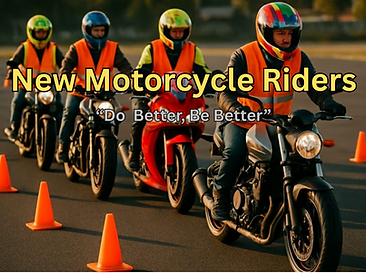The Unseen Consequences of Motorcycle versus Car Accidents: A Personal Account
- NMR

- May 9
- 4 min read

When it comes to the open road, few experiences rival the thrill of motorcycle riding. The wind on your face and the feeling of freedom are hard to beat. However, this exhilarating pastime carries unique risks, especially when compared to being in a car. I found myself involved in an accident years ago that shattered the illusion of invincibility that riding often brings. This is a personal account of the consequences that come with such an incident and the deeper realities that motorcycle riders face. All accidents aren't avoidable, but all accidents are preventable. Although the accident was 100% the motorist fault due to him running a red light through an intersection, in hindsight could I have prevented it, yes. That's why I stress rider awareness and training. It doesn't matter who's right or wrong only who gets hurt.
Understanding the Differences
The first major difference between a motorcycle and a car accident lies in the physics involved. Motorcycles provide far less protection than cars do. While cars encase their occupants in metal and glass, motorcycles expose riders to the elements and the dangers of a crash. In fact, according to the National Highway Traffic Safety Administration, motorcyclists are nearly 26 times more likely to die in a crash than passengers in cars.
After my accident, the stark contrast became clear. A moment of distraction from another driver led to a preventable accident, with no airbag to cushion the blow and no crumple zone to absorb the impact.
Physical Injuries
Luckily for me my injuries were minor in comparison. The injuries sustained in a motorcycle accident are often severe and distinct. While both motorcycle crashes and car accidents can result in broken bones and life-altering injuries, motorcyclists frequently suffer from road rash, head injuries, and other traumatic injuries.
The mental scars from my accident are also significant. Post-traumatic stress disorder (PTSD) is a common outcome for many riders. The psychological effects are often overlooked in discussions about motorcycle safety, yet they can linger long after physical injuries heal.
Financial Implications
Accidents involving motorcycles can result in substantial financial burdens. Medical bills, rehabilitation costs, and potential modifications to one's living space can accumulate rapidly, creating a heavy financial strain.
A study conducted by the Insurance Institute for Highway Safety found that motorcyclists are more likely to face higher out-of-pocket costs than car owners. Unfortunately, insurance policies might not cover all expenses, leaving riders to navigate hidden costs long after the initial injury. In my case, I faced not only physical pain but also the stress of managing bills and missed workdays, which compounded my hardship.
The Psychological Toll
The aftermath of an accident extends well beyond physical injuries; the psychological effects can be profound. Many motorcyclists struggle to regain a sense of safety and confidence after such a traumatic experience. Once a source of joy, riding can morph into a source of anxiety.
In the weeks following my accident, every sound on the road sent my heart racing. The thought of getting back on my bike filled me with dread. I pondered the fleeting nature of life and the personal responsibility that accompanies riding. The mental barrier to return to riding was more challenging than the physical aspects of my recovery.
Community and Support
Throughout my recovery, I discovered the importance of community support for healing, particularly among motorcycle riders. Being part of a community offers not just camaraderie but also essential resources to navigate the trauma of an accident.
I found comfort in connecting with fellow riders who understood my challenges. Sharing experiences and feelings helped lessen the burden of my experience and illustrated the mutual risks we all face.
Preventative Measures
Rider safety is crucial, and there are several steps that motorcyclists can take to protect themselves:
Wear Quality Safety Gear: Investing in a good helmet, jackets, gloves, and riding boots can significantly reduce injury severity. Research shows that wearing a proper helmet can lower the risk of head injury by up to 37%.
Participate in Safety Courses: Many states provide motorcycle safety courses that improve riding skills and situational awareness.
Adopt a Defensive Riding Mindset: Staying aware of your surroundings and anticipating potential dangers can make a significant impact on your safety.
Advocate for Better Legislation: Engage in efforts to improve road safety laws and awareness surrounding motorcycle riding. The more traffic safety becomes a public focus, the better the conditions for all road users.
Reflection on Motorcycle Riding Safety
Experiencing a motorcycle accident brings to light physical injuries and the emotional and financial strains that can linger long after the initial incident. Recognizing and addressing these aspects is vital for a comprehensive understanding of what motorcyclists endure.
By sharing these insights and experiences, I aim to foster awareness and understanding among both motorcyclists and drivers. Collaboration among all road users can lead to a safer environment and promote responsible behavior that benefits everyone on the road. Beneath the thrill of riding lies the reality of safety, and the unseen consequences can change lives forever.





.png)



Comments